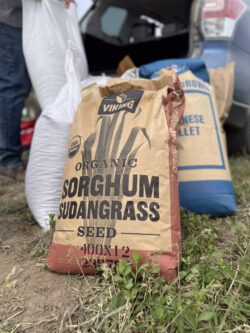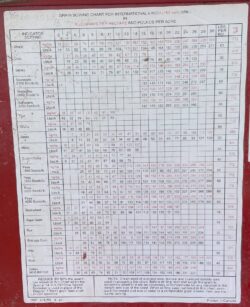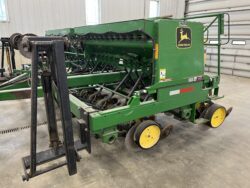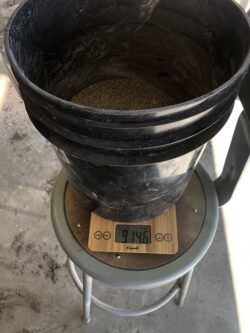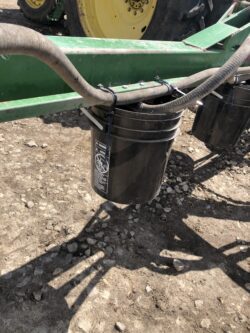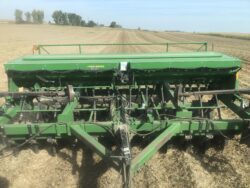Seeding Diverse Cover Crop Mixes: Drilling
Theresa Pedretti | Cover Crop Specialist
Margaret Smith, PhD | Forage Agronomist
Diversity is key for building soil health, and with diversity comes complexity. This new world of seeding complex cover crop mixes includes drilling, seeding with air delivery systems, and broadcast, either by airplane or drone, and requires special effort to get the seeding rate right.
A common question we receive is:
How should I set up my drill for cocktail mixtures? Should I set it for the largest seed in the mix?
Before calibrating your drill, consider:
The seeding rate per acre
Mixes with lower seeding rates (20 lbs/acre or fewer) are usually comprised of small seeds that typically can flow through the grass-seed attachment box on the drill. Examples include our mixes:
- ValueMax (CC2)
- BrassicaMax (CC4)
- MultiMax (CC7)
- Cultivation Max (CC8)
- Plowdown Blend (CC9)
- Corn Builder (CC12)
Mixes calling for higher seeding rates (40 lbs/acre or more) include some large-seeded species, such as rye, peas, or buckwheat. Seed these through the large seed box. Examples include our mixes:
- NitroMax (CC1)
- Winter Max (CC3)
- AerialMax (CC5)
- SummerMax (CC6)
- DiverseMax (CC10)
- FixNMax (CC11)
- Pollinator Max (CC13)
The range of seed sizes in the mix
Seed size influences seeding depth. We suggest you seed at a depth ideal for the mid-sized seeds in your mix. This may plant some small seed a bit deep and some large seed a bit shallow, but—–the compromise for diversity!
Mixes including small seed will tend to sort in the drill box, with small, dense seeds dropping to the bottom. Throughout seeding, either partially fill the box at each ‘refill’ or periodically stop and remix the seed within the box.
Calibration: Step 1
Drill settings on seeding rate charts are calibrated for single species. Using these settings as a starting point, there are ways to home in on the best setting for a diverse cover crop mix.
Find the setting for the largest-sixed seed in your mix—–say peas—to deliver your seeding rate, for your cover crop mix, eg. 50 lbs/A. Using this setting, though, at the recommended seeding rate/A for your mix will result in MORE than 50 lbs/A delivered, due to the small seeds that will readily flow out of the metered openings. You’ll need to make an adjustment. Cut that seeding rate back by 1/3 to ½ for a first calibration run.
For example, if you want to deliver 50 lbs/A of cover crop mix including peas, note the pea setting for 50 lbs/A and cut back to a setting to deliver 25 to 37 lbs/A.
At this point, there is a series of ‘trial runs’ needed to zero in on the actual drill setting to deliver the 50 lbs/A of your mix.
Calibration: Step 2
METHOD 1
- Using the width of the drill, calculate how far you need to drive (or advance the drive wheel or mechanism when stationary) to cover 1/20th of an acre.
Example:
_43,560 ft2/A x 0.5 (1/20th acre)_
Drill width ft x length driven ft.Example for a 15 ft drill:
________2,178 ft 2_______
15 ft x length driven ft.= 145.2 ft
- Either measure the distance needed to drive in the field or advance the drive wheels/mechanism to equal 1/20th of an acre.
- Attach buckets or small, plastic bags to catch seed from seed tubes (you can direct two tubes into each bucket). If using plastic bags, you may want to only capture seed from every other planting unit.
- Either drive 145.2 ft and collect the seed output or advance the drive wheels or alternate mechanism to equal 1/20th (You’ll need to measure the diameter of the drive wheel and calculate the number of revolutions per your linear measurement calculated in step 2. needed to equal 1/20th of an acre). For drills with acre counters, you may need to simulate planting an entire acre.
- Combine the seed from tarp or buckets and weigh (a kitchen scale works well for this application). Weighed seed weight x 20 = seed delivered per acre.
- Check your seed weight with your target seeding rate per acre in pounds.
- Adjust drill/seeder settings and repeat process, as needed, to verify hitting your target seeding rate.
Even after zeroing in on the best setting to deliver your desired rate, the amount delivered may vary once in the field and when planting into worked ground. Monitor seed disappearance as you plant and be prepared to make additional adjustments.
METHOD 2
- For your first seeding pass, fill the seeder full.
- Plant a known area—one to two acres.
- Note how many bags (or lbs) of seed it takes to REFILL the drill or, if seed is from totes, weigh seeds in bucket before refilling the drill/seeder to calculate how many total pounds are needed to refill the seeder.
- Adjust drill/seeder settings and repeat process, as needed, to verify hitting your target seeding rate.
- Remember that as you plant, continually filling the box full will likely result in seed sorting. Consider partially filling the box when actually planting, or periodically stop and remix the seed within the box.
METHOD 3 (Suited for a smaller number of acres)
- Fill the drill box with a small amount of seed to plant one or two acres.
- Plant to empty your seeder and check the pounds of seed delivered to actual acres planted. (The challenge to this method is knowing when your seed box is empty!)
- Adjust drill/seeder settings and repeat process, as needed, to verify hitting your target seeding rate.
Scales can be added to many drills, which simplify the calibration process. If you’re planting 100 acres or more each year with your drill, this can be a good investment and time saver.
Reminder: As with any crop, you may want to purchase an extra bag or two of your premixed or custom cover crop mix (depending on your acres to be planted) to allow for calibration and potential overplanting.
__
Resources:
- Making the Most of Mixtures: Consideration for Winter Cover Crops, Pennsylvania State University
- Calibrating a Grain Drill for a Cover Crop Mixture, Michigan State University
- Calibration of Grain Seed Drills, Pennsylvania State University

